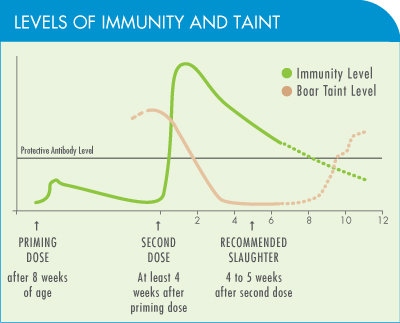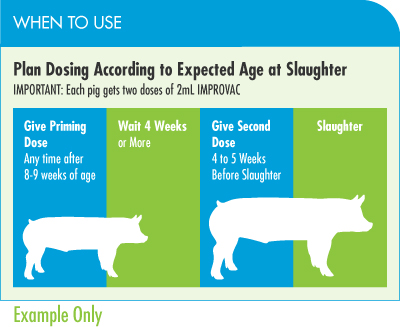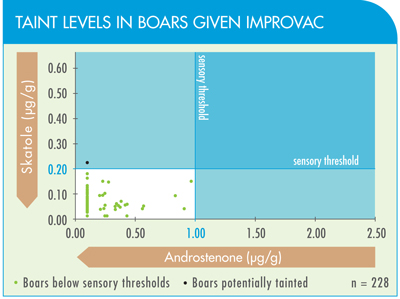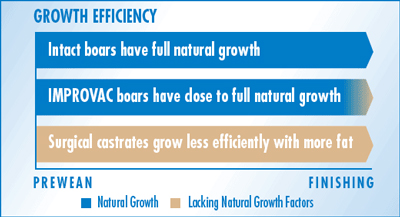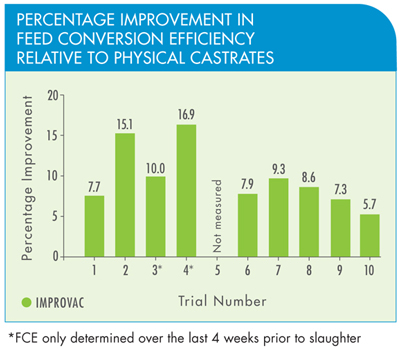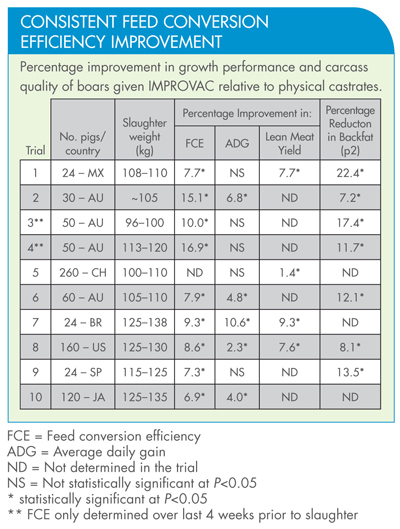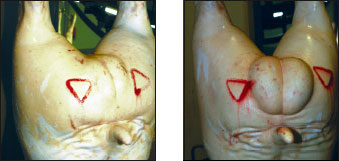Technical Information
Below you will find further detail on the technical information:
- Explanation of two-dose administration
- How to administer
- Research proves efficacy
- IMPROVAC enables pigs to grow like boars
- IMPROVAC consistently delivers improved feed efficiency
- IMPROVAC – on the cutting edge of quality
- Visible efficacy, on farm and at finishing
- IMPROVAC can lessen environmental impact
- Safety for all
Explanation of two-dose administration
An explanation of the two-dose administration of IMPROVAC demonstrates the ease of use of this product:
- The first dose of IMPROVAC primes the pig’s immune system, but does not alter testes size or function.2
- The second dose stimulates the protective immune response that inhibits testes function.2
- Boar taint levels drop dramatically as IMPROVAC takes effect. Androstenone is no longer produced, skatole clearance increases, and testes reduce in size.2
- Optimal time for slaughter is 4 to 5 weeks after the second dose.3
Two 2 mL subcutaneous injections are given at the base of the ear:
- Priming dose at any time after 8 to 9 weeks of age
- Second dose at least 4 weeks after the first dose, and recommended no later than 4 to 5 weeks prior to slaughter
- Timing flexibility to accommodate fast or slow growers
“I’ve never known a product that’s been so reliably effective.”
—John Crane
Associate Director, Global Development
Zoetis
Transcript of Video Text
An important aspect in measuring the efficacy of IMPROVAC is evaluating where a sample falls on a sensory threshold matrix. Sensory threshold is the level above which carcasses are considered to be tainted. These levels can vary, but to be commercially useful they must accurately distinguish tainted from untainted carcasses.4 Proposed threshold values range from 0.5 to 1.0 μg/g for androstenone and 0.20 to 0.25 μg/g for skatole.
Studies show that up to 3% of physical castrates have boar taint levels above the sensory thresholds. This illustrates that current techniques, such as castration, are less than 100% effective.5
In IMPROVAC-related studies such as the following one from New Zealand and Australia, nearly half of 369 boars (100–105 kg) exhibited boar taint, with androstenone and/or skatole in fat tissue above sensory thresholds.
With IMPROVAC, levels of taint compounds fell below the sensory threshold in nearly 100% of boars. The following figure shows that not only do boars vaccinated with IMPROVAC have taint levels below the sensory threshold, but the levels are also extremely low.
- Vaccination with IMPROVAC is as effective in reducing boar taint as current management techniques.2,3
- The IMPROVAC mode of action means that it will work whether testes are normally descended or cryptorchid (retained in the body).
“We’ve done many, many trials throughout the world with IMPROVAC and irrespective of where they were done in the world and how big the studies were, the data sets all said the same thing: this product is as efficacious at controlling boar taint as surgical castration.”
—John Crane
IMPROVAC enables pigs to grow like boars
Prior to the second vaccination, boars vaccinated with IMPROVAC benefit from the natural anabolic growth factors present in intact males.
- Early physical castration to control boar taint removes natural growth factors, thus reducing growth efficiency, feed conversion efficiency and lean tissue.
- Physical castrates require more food, which increases expenses, and produce more fat.2,6
- IMPROVAC permits lean meat production with feed-efficient high rates of natural growth while controlling the occurrence of boar taint at slaughter.2,3,6–10
IMPROVAC consistently delivers improved feed efficiency
In every study where these parameters were measured, boars consistently and significantly demonstrated:
- Better feed efficiency than physical castrates2,3,7–9
- Higher lean meat yield than physical castrates3,6,7,9
- Lower backfat than castrates2,3,7,8
In some studies, vaccinated boars also showed better average daily weight gain.3,8,9
As the above table illustrates, feed conversion efficiency is consistently improved. This has been proven time and again in numerous studies across the globe.3
One study conducted in Germany showed a feed conversion improvement of 9.9% over physically castrated pigs. Pigs were either physically castrated following standard protocols and timing or were vaccinated with IMPROVAC at 11–12 and 20–21 weeks of age. The study was conducted on a commercial research farm, representative of the pig industry in southern Germany. Note particularly the 1.9% significant improvement in lean meat yield and the 9.9% significant reduction in backfat.
Other studies show similar improvements. In the Netherlands, the feed conversion rate was significantly improved – by 8.9% – over physically castrated pigs, while a study in the United States showed a significant feed conversion rate improvement of 8.6%.
IMPROVAC – on the cutting edge of quality
Boars vaccinated with IMPROVAC produce pork with eating qualities at least equal to that produced from physically castrated pigs and gilts.
Studies have shown that the objective parameters of meat quality (colour, marbling, pH and drip loss) in pork from pigs vaccinated with IMPROVAC are at least equivalent to those in pork from physical castrates. Seventeen comparisons between castrates and IMPROVAC vaccinates have been reported, with measures of pH, drip loss, shear force, colour and/or intramuscular fat.11 There was no consistent pattern in one treatment being higher or lower than the other for pH, drip loss, shear force or colour. One may therefore conclude that vaccination with IMPROVAC neither adversely nor positively affects the objective meat quality parameters of pH, drip loss, shear force or colour.
The following photos are from studies in Asia and have been chosen for illustration purposes. While the appearance is not representative of genetics and/or diets in other regions, the carcass changes in leaner breeds are qualitatively similar.
| 1) INTACT BOAR | 2) IMPROVAC | 3) PHYSICAL CASTRATE |
Because pH, drip loss and shear force can directly influence consumers’ assessment of the tenderness of meat, the fact that these parameters were similar between IMPROVAC vaccinated boars and physical castrates indicates that pork from vaccinated boars would be at least as tender as pork from physical castrates, a finding supported by the numerous sensory studies.11
These sensory studies were conducted using either trained sensory panels or consumer panels, which confirm that the eating quality of pork from boars vaccinated with IMPROVAC is at least as high as that of pork from either physical castrates or female pigs. In 15 of 17 studies, pork from vaccinated boars was judged to be of the same quality as pork from either castrates or female pigs. In one study in the UK, pork from IMPROVAC-vaccinated boars was judged to have better quality than pork from non-vaccinated boars, while in another study in Brazil the pork from vaccinated boars was judged to have better sensory quality than pork from physical castrates.11
Visible efficacy, on farm and at finishing
Within 2 weeks of the second dose, testicular production of testosterone has declined by 90% or more.2,3,9
- By the time of slaughter, testes weight is reduced by approximately 50%, with a marked reduction in average size.2,3,7
- The significant reduction in testes size in IMPROVAC-vaccinated boars helps abattoirs to more easily identify vaccinated versus non-vaccinated boars.
| IMPROVAC At slaughter, efficacy is clearly discernible. Testicles are reduced in size and are retained high in the scrotum, evidence of the inhibition of production of testicular compounds. |
INTACT BOAR The presence of full-size testicles signifies the presence and effect of conventional levels of testicular compounds, which contribute to the production of boar taint. |
IMPROVAC can lessen environmental impact
- IMPROVAC contains no chemicals or microbiological agents that pose risks to the environment.
- IMPROVAC helps lessen the environmental impact of pig production and contributes to sustainable pig farming.
How? Improved feed efficiency (approx 8–10%) means that boars given IMPROVAC will produce approximately 8–10% less manure annually compared to physical castrates, which means producers have to dispose of less waste. This is good for the environment because it can decrease the carbon footprint of pig production by reducing green house gas production and reducing the amount of nitrogen and phosphorus in manure.
Why do the boars produce less waste?
Because they consume less feed overall. Decreased feed not only saves the producer money, but it may also provide an environmental benefit.
How? Less feed used means less land and water devoted to growing grain for pig feed. Less grain production means less fuel used in cultivation, harvesting, and transport of grain to the feed mill.
Less grain production also means less power and water used in converting the grain into stock feed.
Consequentially, less fuel and power consumption in the growing of grain and production of stock feed means less green house gas production from farm machinery and transport vehicles.
Pork from boars vaccinated with IMPROVAC is completely safe for human consumption.
- IMPROVAC is not a genetically engineered product and contains no microbiological agents that could pose a risk to the environment
- IMPROVAC has no oral activity if ingested12,14
- IMPROVAC is as effective as physical castration in the successful elimination of boar taint2,5,13
- Similar to most vaccines, IMPROVAC leaves no traces in pork that can affect human health1
- IMPROVAC neither stimulates hormone secretion nor does it add hormones to the pig1
- IMPROVAC has been approved by the national regulatory organisation in over 60 countries with a 0-day withdrawal period.
- With more than 15 years of experience in Australia and New Zealand and more than 7 years in South Africa, Brazil, Mexico and other countries, consumers around the world have already benefited from pork produced using IMPROVAC.
Technical Bulletins
IMPROVAC Consumer Acceptance TB.PDF
IMPROVAC Food Safety TB.PDF
IMPROVAC Mode of Action TB.PDF
IMPROVAC Sensory TB.PDF


